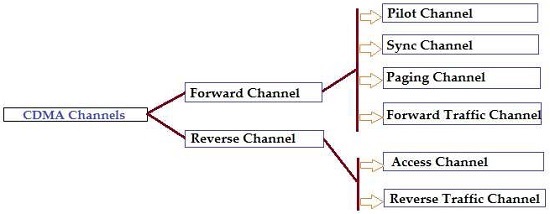
- CDMA - Home
- CDMA - Introduction
- CDMA - Channels
- CDMA - Multiple Access Methods
- CDMA - FDMA Technology
- CDMA - TDMA Technology
- CDMA - Technology
- CDMA - Network
- CDMA - Techniques
- CDMA - Spread Spectrum
- CDMA - Fading
- CDMA - Near-Far Problem
- CDMA - Power Control
- CDMA - Frequency Allocation
- CDMA - Handoff
- CDMA - Interferences
- CDMA Useful Resources
- CDMA - Quick Guide
- CDMA - Useful Resources
- CDMA - Discussion
CDMA - Channels
CDMA channels can be broadly categorized as Forward channel and Reverse channel. This chapter explains the functionalities of these channels.
Forward Channel
The Forward channel is the direction of the communication or mobile-to-cell downlink path. It includes the following channels −
Pilot Channel − Pilot channel is a reference channel. It uses the mobile station to acquire the time and as a phase reference for coherent demodulation. It is continuously transmitted by each base station on each active CDMA frequency. And, each mobile station tracks this signal continuously.
Sync Channel − Synchronization channel carries a single, repeating message, which gives the information about the time and system configuration to the mobile station. Likewise, the mobile station can have the exact system time by the means of synchronizing to the short code.
Paging Channel − Paging Channels main objective is to send out pages, that is, notifications of incoming calls, to the mobile stations. The base station uses these pages to transmit system overhead information and mobile station specific messages.
Forward Traffic Channel − Forward Traffic Channels are code channels. It is used to assign calls, usually voice and signaling traffic to the individual users.
Reverse Channel
The Reverse channel is the mobile-to-cell direction of communication or the uplink path. It consists of the following channels −
Access Channel − Access channel is used by mobile stations to establish a communication with the base station or to answer Paging Channel messages. The access channel is used for short signaling message exchanges such as call-ups, responses to pages and registrations.
Reverse Traffic Channel − Reverse traffic channel is used by the individual users in their actual calls to transmit traffic from a single mobile station to one or more base stations.
